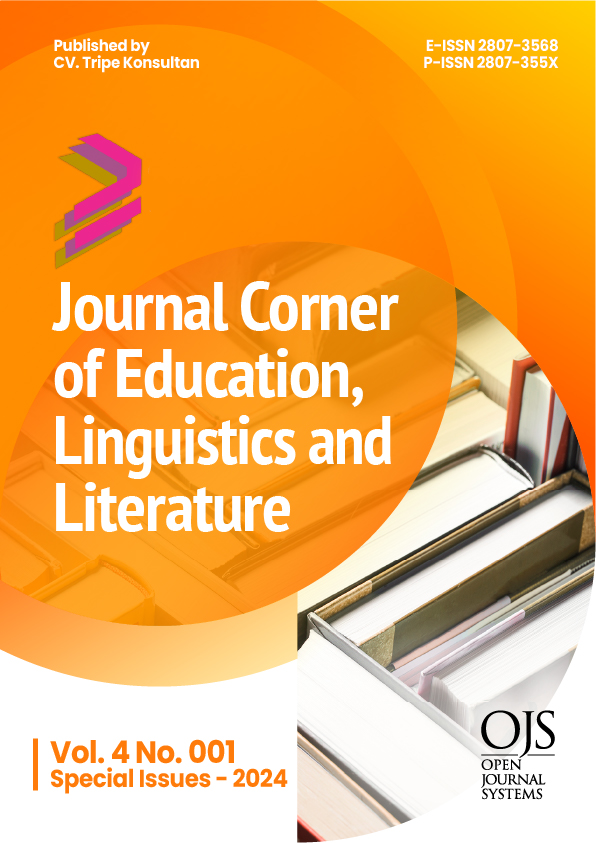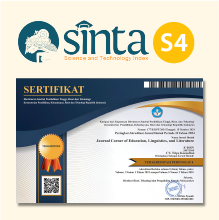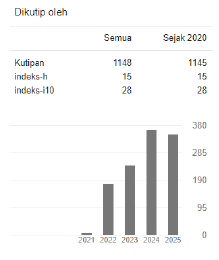The Effectiveness of E-Learning Based Mathematics Learning on High School Students' Learning Outcomes
 https://doi.org/10.54012/jcell.v4i001.505
https://doi.org/10.54012/jcell.v4i001.505
 Abstract views: 90
Abstract views: 90
 PDF downloads: 19
PDF downloads: 19
Keywords:
E-learning, learning outcomes, mathematics, learning models, digitalAbstract
The purpose of this study is to ascertain how well e-learning-based learning models affect the learning outcomes of high school mathematics students. Using a nonequivalent control group design, a quantitative, quasi-experimental methodology is employed. Two XI classes, each with 30 students, during the 2024-2025 school year at State Senior High School 10 Bandar Lampung made up the sample. While the control group employed traditional learning methods, the experimental group employed e-learning-based learning. A multiple-choice learning outcome test that has undergone reliability testing and validation served as the tool. With a significance value of 0.001 (p <0.05), the data analysis results demonstrated that the experimental group's average mathematics learning outcomes (78.60) were substantially greater than the control group's (71.40). The results of the precondition test demonstrated that the data had homogeneous variance and were normally distributed. These results suggest that interactive media, enhanced learning motivation, and flexibility of access are ways that e-learning can enhance student learning outcomes. As a result, e-learning-based math instruction may be a wise choice for raising educational standards in the digital age.
Downloads
References
Al-Emran, M., & Shaalan, K. (2021). E-learning and educational technology adoption in developing countries: A systematic review. Computers & Education, 179, 104429.
Basuony, M. A. K., EmadEldeen, R. E., Farooq, M. B., & Mohamed, E. K. A. (2021). The impact of e-learning on student performance: Evidence from a developing country. Journal of Applied Research in Higher Education, 13(4), 1066–1089.
Dhawan, S. (2021). Online learning: A panacea in the time of COVID-19 crisis. Journal of Educational Technology Systems, 49(1), 5–22.
Heggart, K. R., & Yoo, J. (2023). Getting the blend right: Teaching mathematics through blended learning. Mathematics Education Research Journal, 35, 25–40.
Hodges, C., Moore, S., Lockee, B., Trust, T., & Bond, A. (2021). The difference between emergency remote teaching and online learning. EDUCAUSE Review. Retrieved from https://er.educause.edu
Khalil, R., Mansour, A. E., Fadda, W. A., Almisnid, K., Aldamegh, M., Al-Nafeesah, A., & Al-Wutayd, O. (2021). The sudden transition to synchronized online learning during the COVID-19 pandemic in Saudi Arabia: A qualitative study exploring medical students’ perspectives. BMC Medical Education, 21(1), 285.
Koç, H., & Koç, M. (2022). A meta-analysis of e-learning effectiveness in mathematics education. Education and Information Technologies, 27, 579–603.
Martin, F., Polly, D., & Ritzhaupt, A. D. (2022). Bichronous online learning: Blending asynchronous and synchronous online learning. EDUCAUSE Review, 57(2), 1–11.
Muthuprasad, T., Aiswarya, S., Aditya, K. S., & Jha, G. K. (2021). Students’ perception and preference for online education in India during COVID-19 pandemic. Social Sciences & Humanities Open, 3(1), 100101.
Sun, L., Tang, Y., & Zuo, W. (2022). Coronavirus pushes education online. Nature Materials, 21(2), 105–106.
Tang, Y., & Hew, K. F. (2022). Using online videos for teaching mathematics in K-12 classrooms: A review of the literature. Journal of Computers in Education, 9, 61–89.
UNESCO. (2021). Education in a post-COVID world: Nine ideas for public action. Retrieved from https://unesdoc.unesco.org/ark:/48223/pf0000374029
Wang, C., & DeLaRosby, H. (2023). Exploring high school students’ experiences with digital mathematics learning environments. Educational Studies in Mathematics, 112(1), 121–140.
Yadav, R., & Yadav, M. (2024). Digital transformation in education: Challenges and opportunities for learners. Journal of E-Learning and Knowledge Society, 20(1), 33–45.
Zhang, Y., & Dang, Y. (2023). Investigating the role of student engagement in onlinemathematics learning environments. Interactive Learning Environments, 31(4), 625–640.
Downloads
Published
How to Cite
Issue
Section
License
Copyright (c) 2024 Zulaiha

This work is licensed under a Creative Commons Attribution-ShareAlike 4.0 International License.
All articles published in the Journal Corner of Education, Linguistics, and Literature are licensed under the Creative Commons Attribution-ShareAlike License (CC BY-SA).

















